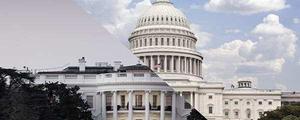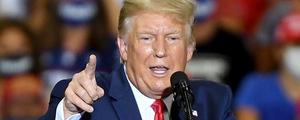Story Highlights
- 62% of Democratic, 28% of Republican voters plan to vote early
- Previously, Republicans and Democrats differed by no more than two percentage points
- 45% of all U.S. voters currently plan to vote before Election Day
Editor's Note: The footnote in the first table has been updated. An earlier version of the story indicated it was the combined percentage who had already voted or planned to vote on (rather than before) Election Day.
WASHINGTON, D.C. -- Major partisan differences in when U.S. registered voters plan to vote have emerged this year that did not exist in prior years. Sixty-two percent of Democratic registered voters plan to vote early or indicate they have already voted, compared with 28% of Republican voters. The 34-percentage-point partisan gap in early voting intentions compares with gaps of no more than two points in the previous four presidential elections.
| Democrat | Independent | Republican | Democratic-Republican gap | ||||||||||||||||||||||||||||||||||||||||||||||||||||||||||||||||||||||||||||||||||||||||||||||||
|---|---|---|---|---|---|---|---|---|---|---|---|---|---|---|---|---|---|---|---|---|---|---|---|---|---|---|---|---|---|---|---|---|---|---|---|---|---|---|---|---|---|---|---|---|---|---|---|---|---|---|---|---|---|---|---|---|---|---|---|---|---|---|---|---|---|---|---|---|---|---|---|---|---|---|---|---|---|---|---|---|---|---|---|---|---|---|---|---|---|---|---|---|---|---|---|---|---|---|---|
| % | % | % | pct. pts. | ||||||||||||||||||||||||||||||||||||||||||||||||||||||||||||||||||||||||||||||||||||||||||||||||
| 2020 | 62 | 47 | 28 | 34 | |||||||||||||||||||||||||||||||||||||||||||||||||||||||||||||||||||||||||||||||||||||||||||||||
| 2016 | 44 | 35 | 42 | 2 | |||||||||||||||||||||||||||||||||||||||||||||||||||||||||||||||||||||||||||||||||||||||||||||||
| 2012 | 37 | 32 | 37 | 0 | |||||||||||||||||||||||||||||||||||||||||||||||||||||||||||||||||||||||||||||||||||||||||||||||
| 2008 | 35 | 29 | 33 | 2 | |||||||||||||||||||||||||||||||||||||||||||||||||||||||||||||||||||||||||||||||||||||||||||||||
| 2004 | 22 | 19 | 24 | -2 | |||||||||||||||||||||||||||||||||||||||||||||||||||||||||||||||||||||||||||||||||||||||||||||||
| Figures are the combined percentages who say they have already voted or plan to vote before Election Day; 2020 data are based on Sept. 14-28 poll. Prior years based on final preelection poll. | |||||||||||||||||||||||||||||||||||||||||||||||||||||||||||||||||||||||||||||||||||||||||||||||||||
| Gallup | |||||||||||||||||||||||||||||||||||||||||||||||||||||||||||||||||||||||||||||||||||||||||||||||||||
Before this year, all party groups had shown steady increases in early voting as states expanded these opportunities or moved to all-mail elections. Between 2004 and 2016, early voting increased by 22 points among Democrats, 18 points among Republicans and 16 points among independents. This year, amid the coronavirus pandemic, there has been a surge of early voting intentions among Democrats (18 points) and independents (12 points), but a sharp decline among Republicans (14 points) compared with 2016.
The Republican trend suggests these voters are adjusting their behavior to be consistent with President Donald Trump's ongoing messaging against mail voting, which he claims will lead to widespread fraud in the election.
All told, 45% of U.S. registered voters plan to vote early, including 1% who had already voted by the time they were interviewed for the Sept. 14-28 poll. That represents a modest increase from what Gallup measured immediately before the 2016 election (40%) and a more substantial increase from prior years. Half of voters say they plan to vote on Election Day itself this year.
| Voted/Plan to vote before Election Day | Plan to vote on Election Day | ||||||||||||||||||||||||||||||||||||||||||||||||||||||||||||||||||||||||||||||||||||||||||||||||||
|---|---|---|---|---|---|---|---|---|---|---|---|---|---|---|---|---|---|---|---|---|---|---|---|---|---|---|---|---|---|---|---|---|---|---|---|---|---|---|---|---|---|---|---|---|---|---|---|---|---|---|---|---|---|---|---|---|---|---|---|---|---|---|---|---|---|---|---|---|---|---|---|---|---|---|---|---|---|---|---|---|---|---|---|---|---|---|---|---|---|---|---|---|---|---|---|---|---|---|---|
| % | % | ||||||||||||||||||||||||||||||||||||||||||||||||||||||||||||||||||||||||||||||||||||||||||||||||||
| 2020 | 45 | 50 | |||||||||||||||||||||||||||||||||||||||||||||||||||||||||||||||||||||||||||||||||||||||||||||||||
| 2016 | 40 | 54 | |||||||||||||||||||||||||||||||||||||||||||||||||||||||||||||||||||||||||||||||||||||||||||||||||
| 2012 | 35 | 61 | |||||||||||||||||||||||||||||||||||||||||||||||||||||||||||||||||||||||||||||||||||||||||||||||||
| 2008 | 32 | 64 | |||||||||||||||||||||||||||||||||||||||||||||||||||||||||||||||||||||||||||||||||||||||||||||||||
| 2004 | 21 | 77 | |||||||||||||||||||||||||||||||||||||||||||||||||||||||||||||||||||||||||||||||||||||||||||||||||
| 2020 data based on Sept. 14-28 survey; Prior years based on final preelection surveys. Figures for registered voters who do not plan to vote are not shown. | |||||||||||||||||||||||||||||||||||||||||||||||||||||||||||||||||||||||||||||||||||||||||||||||||||
| Gallup | |||||||||||||||||||||||||||||||||||||||||||||||||||||||||||||||||||||||||||||||||||||||||||||||||||
While the 45% appears to be only a slight increase over what occurred in 2016, past Gallup trends indicate that the proportion of early voters will grow over the course of the campaign. In prior election years in which the early voting question was asked multiple times during the campaign, the proportion who reported having voted or planning to vote before Election Day grew by four to 10 points between the initial measurement and the end of the campaign.
| Initial measure | Final measure | Difference | |||||||||||||||||||||||||||||||||||||||||||||||||||||||||||||||||||||||||||||||||||||||||||||||||
|---|---|---|---|---|---|---|---|---|---|---|---|---|---|---|---|---|---|---|---|---|---|---|---|---|---|---|---|---|---|---|---|---|---|---|---|---|---|---|---|---|---|---|---|---|---|---|---|---|---|---|---|---|---|---|---|---|---|---|---|---|---|---|---|---|---|---|---|---|---|---|---|---|---|---|---|---|---|---|---|---|---|---|---|---|---|---|---|---|---|---|---|---|---|---|---|---|---|---|---|
| % | % | pct. pts. | |||||||||||||||||||||||||||||||||||||||||||||||||||||||||||||||||||||||||||||||||||||||||||||||||
| 2012 | 25 (Oct 1-7) | 35 (Nov 1-4) | +10 | ||||||||||||||||||||||||||||||||||||||||||||||||||||||||||||||||||||||||||||||||||||||||||||||||
| 2008 | 27 (Oct 17-19) | 32 (Oct 31-Nov 2) | +5 | ||||||||||||||||||||||||||||||||||||||||||||||||||||||||||||||||||||||||||||||||||||||||||||||||
| 2004 | 17 (Sep 24-26) | 21 (Oct 29-31) | +4 | ||||||||||||||||||||||||||||||||||||||||||||||||||||||||||||||||||||||||||||||||||||||||||||||||
| In 2016 only one measure was taken, in the final preelection poll | |||||||||||||||||||||||||||||||||||||||||||||||||||||||||||||||||||||||||||||||||||||||||||||||||||
| Gallup | |||||||||||||||||||||||||||||||||||||||||||||||||||||||||||||||||||||||||||||||||||||||||||||||||||
The trends suggest that with 45% already planning to vote early, by the morning of Election Day, Nov. 3, a majority of votes for president may have already been cast. The total could rise even further if coronavirus infections spike in October and additional voters opt to avoid large crowds by voting early or sending in a mail ballot.
Most Early Voting Will Be Done by Absentee
Of those planning to vote early, 60% say they will vote by absentee ballot, 31% will vote in person and 9% are unsure how they will vote.
Overall, 57% of U.S. voters plan to vote in person and 29% by mail, with another 8% unsure. Gallup has not asked about intended voting method in past elections, so it is unknown how much mail voting might increase this year over prior years. Absentee ballot requests have grown substantially in many states, and several states are mailing ballots to all registered voters.
Taking into account both how voters plan to vote and when they plan to vote:
- 44% of U.S. registered voters plan to vote in person on Election Day.
- 13% plan to vote in person before Election Day.
- 27% plan to vote by mail or absentee ballot before Election Day.
- 2% say they will vote by mail or absentee ballot on Election Day, perhaps indicating they will drop off or mail their ballot on Election Day.
- 8% are unsure of their voting method, split evenly between those who plan to vote early and those planning to vote on Election Day.
Aside from Democrats, other groups inclined to vote early and to vote by mail include adults aged 65 and older, college graduates, upper-income Americans and Western residents.
Implications
With the majority of votes likely being cast before Election Day, campaigning has accelerated. But the surge in early voting intentions is limited to Democrats and independents. Republican voters, after years of gravitating toward early voting, are now significantly less likely to vote early than they were in the last election. Perhaps Republicans, among whom more than 90% approve of the job he is doing as president, are being deterred from mail voting by Trump's messaging.
That stark partisan contrast in voting methods may contribute to the uncertainty about the winner of the election. In states where mail ballots are not tabulated until Election Day, the early voting returns may show Trump leading, perhaps widely, in states he may ultimately lose once all mail ballots are tabulated. As such, the speed with which Americans know the winner of the election could depend on how quickly absentee ballots can be counted.
View complete question responses and trends (PDF download).
Learn more about how the Gallup Poll Social Series works.





